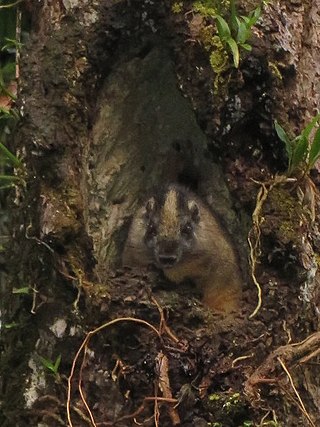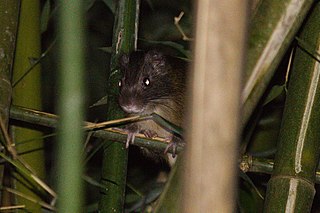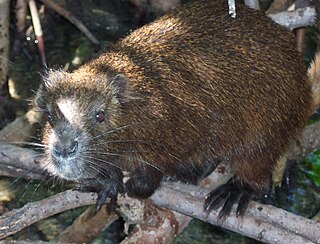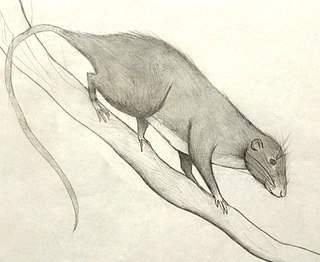
The fat sand rat is a terrestrial mammal from the gerbil subfamily that is mostly found in North Africa and the Middle East, ranging from Mauritania to the Arabian Peninsula. This species usually lives in sandy deserts, but may also be found in rocky terrain or saline marsh areas. Fat sand rats are very selective in their diet, only eating stems and leaves of plants from the family Amaranthaceae, more commonly known as the amaranth family. In captivity, fat sand rats can become obese and rapidly develop diabetes-like symptoms when fed the diet typically given to other rodents. P. obesus has an average lifespan of 14 months in the wild and 3–4 years in captivity.

Gerbillinae is one of the subfamilies of the rodent family Muridae and includes the gerbils, jirds, and sand rats. Once known as desert rats, the subfamily includes about 110 species of African, Indian, and Asian rodents, including sand rats and jirds, all of which are adapted to arid habitats. Most are primarily active during the day, making them diurnal, and almost all are omnivorous.

The painted tree-rat is a species of spiny rat from Brazil, restricted to north-eastern Bahia in eastern Brazil. It is the only species in the genus Callistomys.

The toros or brush-tailed rats, genus Isothrix, are a group of spiny rats found in tropical South America, particularly in the Amazon Basin.
The giant tree-rat is a species in the family Echimyidae, the spiny rats. It is the only species in the monotypic genus Toromys. It is endemic to Brazil, where it occurs in the flooded forest along the banks of the Amazon River and its tributaries.

The Atlantic bamboo rat, or southern bamboo rat, is a spiny rat species found in humid tropical forests in Argentina, Brazil and Paraguay. It is the only member of the genus Kannabateomys.
The tuft-tailed spiny tree rat is a spiny rat species from Brazil south of the Amazon River, where it has been found in grassland and gallery forest. It is the only species in the genus Lonchothrix. Very little is known about this rodent. It is small with an average adult weight of about 138 grams. It is nocturnal and solitary in habits.
The long-tailed armored tree-rat, is a spiny rat species from South America. It is found in Brazil, with a population in Ecuador which is referable either to this species or to Makalata didelphoides. Initially considered a large form of the latter species, it actually represents a distinct species as supported by morphological and molecular characters.
Phyllomys is a genus of arboreal spiny rat, geographically restricted to the forests of eastern Brazil.

Mesomys is a genus of South American spiny rats in the family Echimyidae.

Echimys is a genus of the spiny rats family, the Echimyidae. Members of this genus are collectively called spiny tree-rats.

Desmarest's hutia or the Cuban hutia is a stout, furry, rat-like mammal found only on Cuba and nearby islands. Growing to about 60 cm (2 ft), it normally lives in pairs and feeds on leaves, fruit, bark and sometimes small animals. It is the largest living hutia, a group of rodents native to the Caribbean that are mostly endangered or extinct. Desmarest's hutia remains widespread throughout its range, though one subspecies native to the nearby Cayman Islands went extinct shortly after European colonization in the 1500s.

Dactylomys is the genus of South American bamboo rats They are arboreal members of the family Echimyidae.

Lemniscomys, sometimes known as striped grass mice or zebra mice, is a genus of murine rodents from Africa. Most species are from Sub-Saharan Africa; L. barbarus is the only one found north of the Sahara. They are generally found in grassy habitats, but where several species overlap in distribution there is a level of habitat differentiation between them.

Euryzygomatomys is a genus of South American rodents, commonly called guiaras, in the family Echimyidae. It contains two extant and one fossil species, found in Argentina, Brazil and Paraguay. They are as follows:
Neusticomys is a genus of semiaquatic, animalivorous South American rodents in the family Cricetidae.
The thin sand rat or lesser sand rat is a species of rodent in the family Muridae. It has also been previously named the pale sand rat based on work published by Oldfield Thomas in 1925. It is found in Algeria, Libya, and Tunisia, and its natural habitats are subtropical or tropical dry shrubland and intermittent salt lakes. The thin sand rat was previously classified as a subspecies of the fat sand rat. However, morphological differences in size and coat color between the two animals, along with recent molecular evidence suggest that they are different species. The thin sand rat may be a natural reservoir for the disease leishmaniasis.
The Peruvian tree rat is a species of rodent in the family Echimyidae. It is found in northeastern Peru and adjacent Ecuador, where it is found in the Amazon rainforest. It is nocturnal and arboreal.

The armored rat is a species of rodent in the family Echimyidae. It is monotypic within the genus Hoplomys. It is found in Latin America, from northern Honduras to northwest Ecuador. It possesses a range of spines on its back and sides of the body.
Clyomys is a South American rodent genus in the family Echimyidae. It contains two species, found in tropical savannas and grasslands from circa 100 m (300 ft) to 1,100 m (3,600 ft) elevation in central Brazil and eastern Paraguay.












